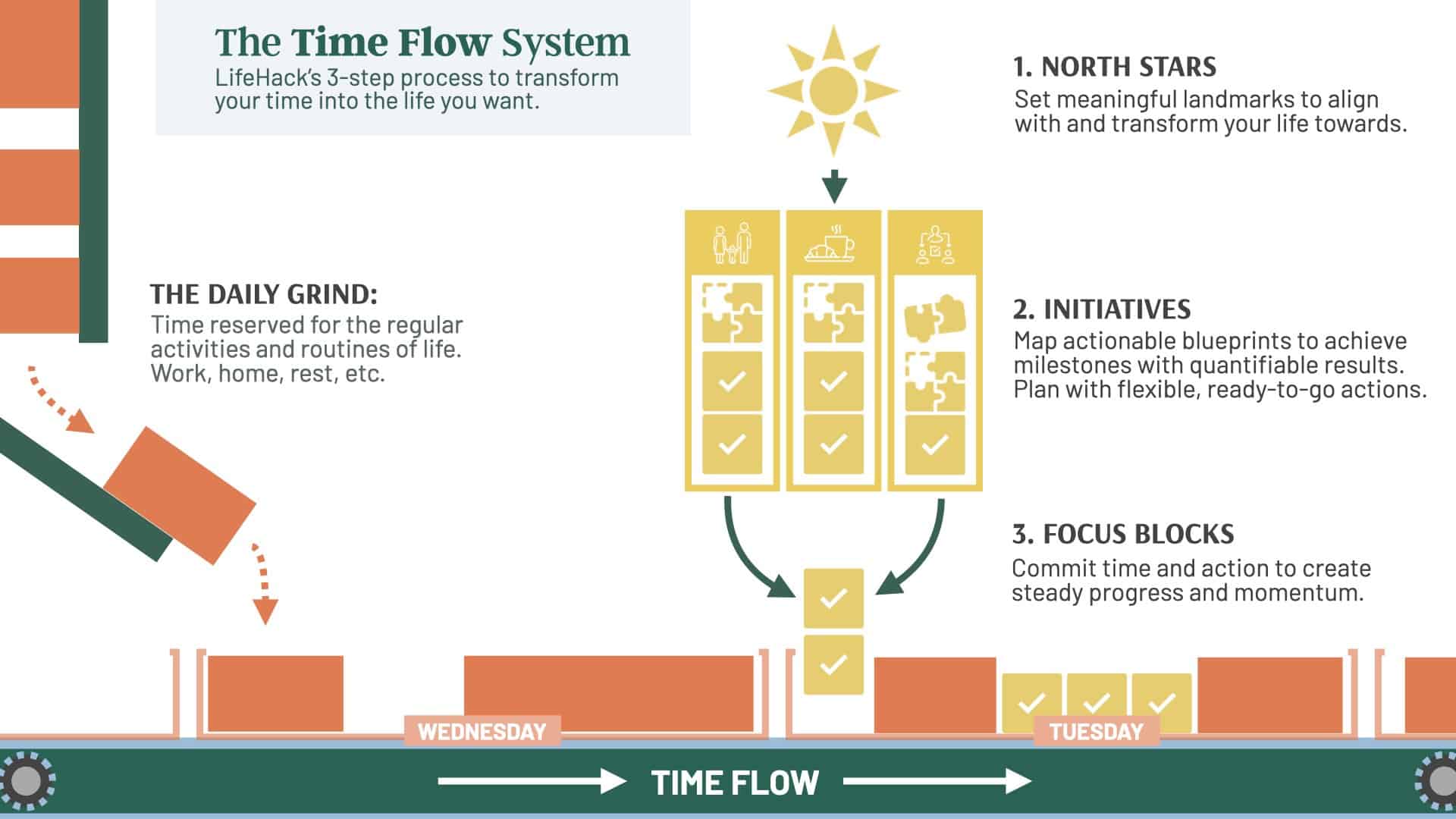How the Time Flow System Works
By Leon Ho, Founder of Lifehack
In the grand river of life and work, “flow” is the current that propels us forward —continuous, smooth, steady. There’s no stagnant water in this stream, only the unstoppable momentum of progress.
Now, you might wonder, how do we keep this flow going? How do we navigate the rapids of distractions and the whirlpools of procrastination?
The answer:
With the 3 steps of the Time Flow System — North Stars, Initiatives, and Focus Blocks.

Imagine these steps as cascading waterfalls. Each one leads naturally to the next, creating a cycle of productivity and progress. The North Stars guide us, the Initiatives chart our course, and the Focus Blocks keep us moving downstream.
In the following sections, we’ll dive into each step, helping you understand how they translate into logical actions, providing a steady rhythm to your time and productivity.
As we delve into the mechanisms of the Time Flow System, you’ll find that your work no longer feels like rowing upstream but rather, sailing smoothly downstream with the current on your side.
Table of Contents
1. The Flow Starts with… North Stars
North Stars are celestial bodies lighting up the night sky, usually inspiring and illuminating, helping the lost to find directions.
In the context of the Time Flow System, North Stars also help you to find your direction. They symbolize the guiding principles in your life, representing the major life scenarios, stages, or landmarks that you truly desire to reach.
The Symbolism of North Stars
Imagine standing in a vast open field with your eyes locked onto a distant beacon. That’s your North Star. It offers alignment and direction, ensuring that your actions are always driven by a greater purpose.
These are not fleeting whims, but the bold, ambitious visions that spur you forward. They resonate with core beliefs and ideals, providing consistency and stability amidst the uncertainties of life.
Consistent North Stars
Despite the system being flexible and adaptable to your ever-changing needs and desires, North Stars should remain largely consistent.
Think of them as your life’s lighthouses. Unless there’s a seismic shift in your life, you don’t change your North Star casually.
Milestones: Practical Steps Toward Your North Star
However, as inspirational as these North Stars might be, it’s often overwhelming to try and reach them in a single leap. That’s where Milestones come in.
Milestones are like signposts on the road to your North Star, marking your journey and keeping you grounded. They break down your long-term visions into smaller, more manageable, and quantifiable objectives.
The Role of Milestones
Milestones are the tactical plans that guide you towards your North Stars. They allow for measurement, accountability, and flexibility, ensuring a well-defined path that can adapt as needed.
They offer balance between inspiration and pragmatism, fueling your passion and drive while offering a practical and organized way to make progress.
Integration of North Stars and Milestones
In short, the North Stars are your compass, offering a stable direction amidst the uncertainties of life. And Milestones are your roadmap, providing tangible steps to realize your dreams. Together, they set the stage for a productive, focused, and purposeful journey.
By combining the symbolism and inspirational power of North Stars with the practical implementation of Milestones, they create a coherent methodology for intentional living.
Whether you’re looking to advance in your career, nurture relationships, or explore personal passions, this system of North Stars and Milestones provides alignment, balance, motivation, and celebration, weaving a path from dreams to reality.
Your North Stars and Milestones should align, every Milestone you set should be a step towards reaching one or more of your North Stars. The integrated approach of North Stars and Milestones constitutes a powerful framework for sustained growth and fulfillment in various aspects of life.
2. Flows Down into… Initiatives
So, you’ve identified your North Stars and charted out your Milestones. Next is to fire up the engines of progress: the Initiatives. These act as actionable blueprints to your dreams, bridging the gap between grand visions and practical execution.
Initiatives: Your Actionable Blueprints
Think of Initiatives as the actionable blueprints to your dreams. They’re not grand and lofty like North Stars, or distant like Milestones. Instead, they’re specific, targeted plans and actions you set to march toward a quantifiable objective.
They are the concrete, measurable steps that are tied directly to your Milestones and ultimately, to your North Stars.
Initiatives Are Malleable
However, it’s crucial to remember that Initiatives are not carved in stone. Rather, they are more like clay – malleable, evolving, and constantly reshaped by your hands. They demand frequent evaluation and adaptation.
This dynamic nature ensures that Initiatives remain aligned with your evolving circumstances and maintain a relevant connection to your Milestones.
Guiding Question for Initiatives
The guiding question behind every Initiative is simple yet profound:
“How does this align with my North Star?”
It’s not about merely ticking off tasks on your to-do list. That might give you a temporary feeling of accomplishment, but without clear purpose and alignment, it can lead to a hollow sense of progress.
The goal is to filter out actions that don’t move the needle toward your North Star. Every action under an Initiative should be scrutinized – its relevance assessed, its impact evaluated, and its worthiness tested.
Actions: The Building Blocks of Initiatives
Each Initiative can even be further broken down into Actions — these are the specific steps and tasks that make up your Initiatives. This advanced level of detail provides additional structure and clarity, helping you chart out a precise path forward.
Actions are the tangible activities that breathe life into Initiatives, making them actionable and accountable. They ensure that every ounce of your energy and every minute of your time are invested wisely, fueling your journey toward the North Star.
Aligning Initiatives and Actions with Your Journey
Initiatives and Actions are more than just tasks; they are the structured strategies and disciplined execution that turn dreams into realities. They make your path not only visionary but also tangible and achievable, leading you consistently and effectively towards the fulfillment of your North Stars.
And with that, we’re ready to proceed to the final phase of the Time Flow System: the Focus Blocks.
3. Flows Down into… Focus Blocks
With your North Stars guiding you and your Initiatives setting the course, it’s time to roll up your sleeves and take action. This is where the final element of our Time Flow System comes into play: the Focus Blocks.
Focus Blocks are bite-sized power-packs of productivity that are instrumental in bringing your dreams to fruition.
The Essence of Focus Blocks: Building Your Grand Vision
If Initiatives are the blueprints to your grand vision, Focus Blocks are the bricks that build it.
They are the minimum unit of progress, the dedicated chunks of time that make your aspirations a reality. This makes them the crucial hands-on element, turning abstract ideas into tangible outcomes.
Structure and Simplicity
Focus Blocks are refreshingly straightforward. They consist of two simple elements: the action to be taken and the time dedicated to it.
This clear and concise structure ensures that Focus Blocks are both actionable and manageable, allowing for targeted efforts towards your goals.
Choosing the Right Actions
Each Focus Block is the result of careful planning, prioritization, and evaluation. These actions don’t randomly stumble into a Focus Block. Rather, they’re deliberately chosen because they align with your Initiatives and, by extension, your North Stars.
This alignment ensures that every effort you make is intentional and resonates with your overarching vision.
Quality over Quantity
The magic of Focus Blocks lies in their emphasis on quality over quantity. It’s not about packing in more and more actions; rather, it’s about choosing the right actions that make the most impact.
Less is more. This philosophy promotes effectiveness over mere busyness, ensuring that every action contributes meaningfully to your objectives.
Fitting Focus Blocks into Your Life
In terms of flexibility, Focus Blocks are incredibly adaptable. You shape them to fit into your schedule and constraints, not the other way around.
They’re like puzzle pieces, fitting snugly into the gaps of your day, ensuring progress is made no matter how busy you might be. This adaptability makes them a versatile tool in various life situations and stages.
Controlling the Pace
The more Focus Blocks you commit to, the faster you’ll progress toward your North Star. They’re the speed dial of your journey, allowing you to control the pace of your progress.
So, besides setting aside time for progress, Focus Blocks determine how swiftly you traverse the path to your goals. They embody the dynamic relationship between planning, execution, and progress, forming a powerful mechanism for personal growth and achievement.
Focus Blocks as a Catalyst for Success
Focus Blocks are not just a method of time management or task organization; they are a powerful strategy that empowers you to realize your North Stars.
By integrating planning, alignment, quality, flexibility, and control, Focus Blocks act as the catalyst that translates your dreams into reality. They represent the refined essence of productivity, leading you consistently and effectively towards success.
With Focus Blocks, the path to your goals becomes not only visionary but also actionable, measurable, and enjoyable.
Let’s bring the Time Flow System to life with some case studies:
Case Study 1: Emily, a Busy Manager at Work

Emily is a classic example of a hardworking, diligent manager who finds herself lost in the whirlwind of tasks, deadlines, and responsibilities. Despite her best efforts, she often feels overwhelmed and struggles to strike a healthy work-life balance. She’s like a sailor caught in a storm, with the boat rocking, waves crashing, and no sight of calm water.
The root of Emily’s challenge lies in her ineffective time management and delegation skills. Coupled with her perfectionist nature and a desire to maintain control, she often bites off more than she can chew, resulting in an unmanageable workload. She’s caught in a hamster wheel of urgent but not always important tasks, affecting not just her but also her team’s performance and morale.
But with The Time Flow System, Emily can navigate out of this storm:
1. Finding Her North Star
Emily needs to define what she truly wants. Not just work-related goals but the kind of life she aspires to lead.
In Emily’s case, her North Star is to achieve a work-life balance while excelling in her managerial role. That’s her guiding light, the beacon towards which all her actions should steer.
2. Identify Her Initiatives
These are the engines that propel Emily toward her North Star. Here, Emily needs an Initiative that addresses her current challenges: Effective Delegation and Time Management.
Her objective: Delegate tasks efficiently and manage her time effectively to maintain a healthy work-life balance.
3. The Focus Blocks
The Focus Blocks are dedicated chunks of time where Emily commits to taking specific actions that align with her Initiative and, therefore, her North Star.
Emily’s weekly Focus Blocks might look something like this:
- Focus Block 1 (0.5 hour): She categorizes tasks based on urgency and importance, creating a clearer view of her workload every week.
- Focus Block 2 (2 hours): Emily delegates tasks to team members, ensuring she communicates clear instructions and expectations by creating guidelines and manual.
- Focus Block 3 (0.5 hour): She sets up weekly check-ins with her team to monitor progress and provide support as needed.
- Focus Block 4 (2 hours): Emily commits time every week for personal development and skill enhancement. After all, a better Emily makes a better manager.
By adhering to these Focus Blocks, Emily not only works towards her North Star but also paces her journey to prevent burnout. With each Focus Block, she steps closer to her goals, managing her time, and leading her team more effectively.
Case Study 2: Sarah, a Work-From-Home Parent

Sarah is a working parent who enjoys the flexibility of working from home. The opportunity to spend more time with her children while continuing her professional career is a benefit she values greatly. However, finding a balance between these two key roles is often a juggling act for her. The blur between professional responsibilities and parenting duties can lead to inefficiencies in both arenas.
Sarah’s challenges stem from a lack of structure. She’s frequently shifting between work and personal tasks, leading to distractions and reduced productivity. Her home environment, though comforting, lacks the boundaries often provided by a separate workplace, causing interruptions and challenges in focusing on tasks at hand. This juggling act is causing stress, reducing productivity, and affecting the quality of time she spends with her children.
Here’s how Sarah can tackle her challenge with the Time Flow System:
1. Finding Her North Star
Sarah’s North Star is to balance her professional responsibilities with parenting duties while working from home. This is her overarching goal, the dream that drives all her actions and decisions.
2. Identify Her Initiatives
Sarah’s Initiative is Creating a Structured Routine. Her objective is to establish a routine that gives her focused time for work and dedicated quality time with her kids.
3. The Focus Blocks
The tangible actions that make up her day can be:
- Focus Block 1 (1 hour): Sarah sets her morning routine, focusing on self-care, planning the day’s tasks, and prepping her kids for their day. A good start often leads to a great day.
- Focus Block 2 (3 hours): She carves out time for uninterrupted work. Here, she could use productivity techniques like time blocking or the Pomodoro Technique.
- Focus Block 3 (1 hour): It’s time to switch gears and focus on the kids. This hour is about engaging with them, joining in their activities, and creating moments of connection.
- Focus Block 4 (1 hour): Sarah uses mealtime as an opportunity to foster togetherness, preparing and enjoying food with her family.
- Focus Block 5 (1 hour): As the day winds down, Sarah devotes time to calming activities with her children before bedtime, like reading stories.
These Focus Blocks create a roadmap for Sarah’s day, aligning with her North Star. By implementing this system, Sarah can address her challenges, improve her productivity, and enhance her interactions with her kids.
Case Study 3: Mark, a Professional Struggling with Health Issues

Mark is a hard-working professional balancing his demanding job with serious health issues. His hectic professional life, filled with projects and deadlines, leaves little room for self-care. Mark’s chronic health concerns, coupled with the pressures of work, lead to fatigue, pain, and lack of focus, further impacting his performance and well-being.
It’s a tricky cycle. The need to maintain high productivity at work often pushes Mark to disregard his health. He might skip meals, neglect taking breaks, or sacrifice self-care to meet work expectations. But as we all know, such neglect can make health problems worse, leading to a destructive cycle of deteriorating health and decreasing work performance.
Moreover, the stress of constantly meeting work targets can worsen Mark’s health conditions. The demanding nature of his work leaves him with little time or energy to care for his health proactively.
Communication barriers add to the stress. If his colleagues or superiors lack understanding about his health conditions, it’s challenging to get the support or adjustments he needs. This impacts on Mark’s physical and mental well-being, and his personal and professional life.
But with the Time Flow System, Mark can find his way out of this tough situation:
1. Finding His North Star
Mark’s North Star is clear: Prioritize self-care and manage health issues while maintaining productivity at work.
2. Identify His Initiatives
His Initiative is Balancing Work and Health. His Objective is to develop strategies to manage his health while maximizing work productivity.
3. The Focus Blocks
His Focus Blocks can be like:
- Focus Block 1 (30 minutes): Mark starts his day with exercises or stretching, boosting his energy and improving physical well-being.
- Focus Block 2 (3 hours): He dedicates his high-energy hours to the most critical work tasks. By doing the most demanding tasks when he’s feeling at his best, he optimizes productivity.
- Focus Block 3 (15 minutes): Mark takes regular breaks to stretch, hydrate, and relax. This helps ease the physical strain that comes with his health issues.
- Focus Block 4 (1 hour): Meal planning and preparation take the front seat to ensure he has nutritious food that supports his health.
- Focus Block 5 (30 minutes): Mark sets time aside for self-care activities that boost his mental well-being, such as meditation or engaging in a hobby.
By implementing these Focus Blocks, Mark can break his destructive cycle. He can make room for his health needs, take control of his well-being, and still fulfill his work responsibilities effectively.
The Bottom Line
Whether you’re an overwhelmed manager like Emily, a working parent juggling multiple responsibilities like Sarah, or a busy worker managing health issues like Mark, the challenges of time management are universal. We all share the feeling that there aren’t enough hours in the day to get everything done. However, this feeling won’t last forever. It’s merely a signal that we need a better system.
And that’s where the Time Flow System comes in. It’s a practical, realistic way to tackle your lack of time problems. You start by identifying your North Star – your key goal or aspiration. Then, you establish Initiatives – clear steps to take you closer to that North Star. Finally, you break down these Initiatives into manageable Focus Blocks – dedicated time slots for action.
Emily moved from feeling overwhelmed to mastering effective delegation and time management, becoming a more balanced and efficient leader. Sarah, by implementing a structured routine, she managed to focus better on her professional tasks while still finding quality time to spend with her children. And let’s not forget Mark, despite his health issues, he learned to balance his work and health, carving out time for self-care without compromising his professional responsibilities.
These aren’t magic transformations – they’re achievable changes that you too can make. Whether you’re swamped with work, navigating the challenges of parenthood, dealing with health issues, or simply seeking to regain control of your time, the Time Flow System is your roadmap to success.
Life is too short to feel constantly short of time. So, why not give the Time Flow System a try so you can stop just surviving your days and start truly living them?

